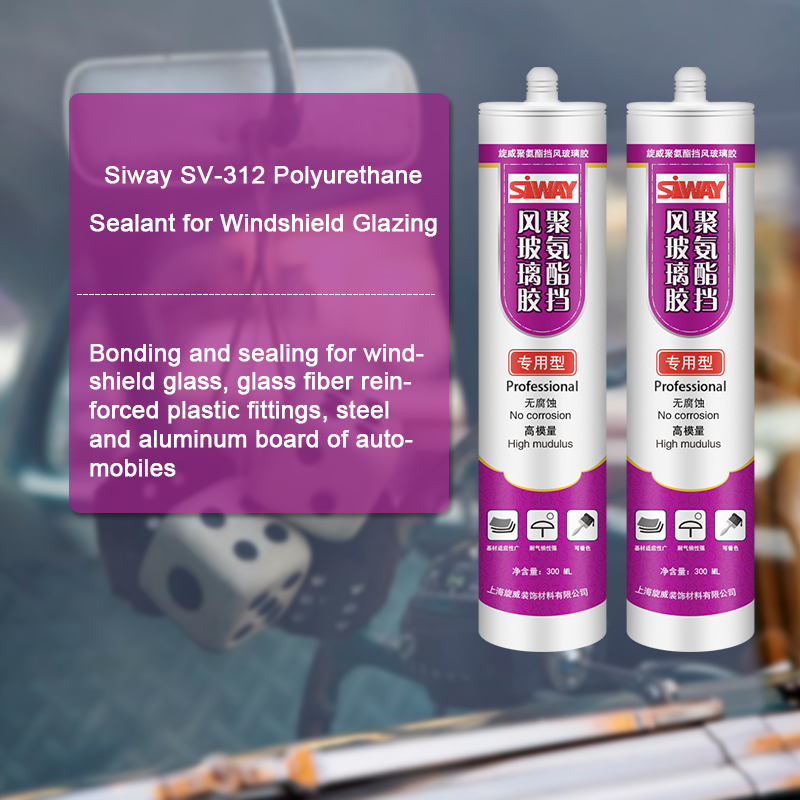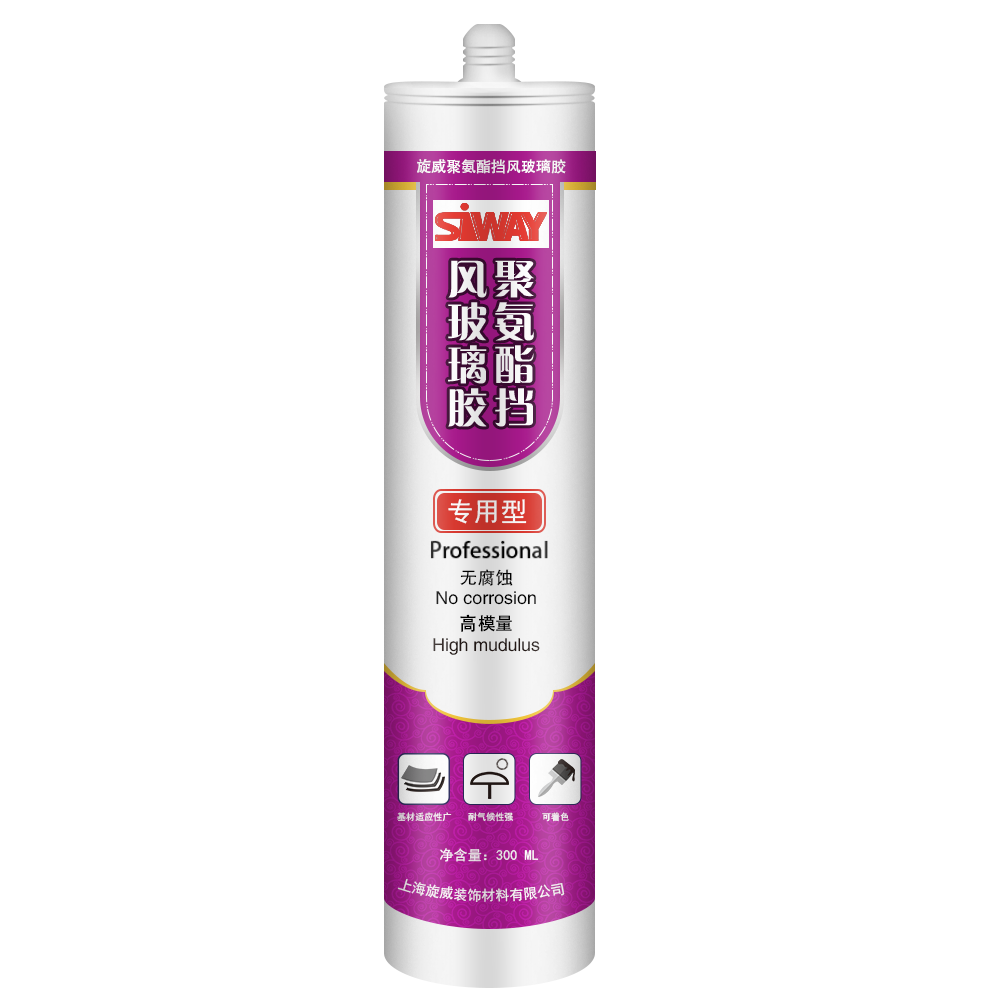14 Years Factory wholesale SV-312 Polyurethane Sealant for Windshield Glazing for Senegal Manufacturers
Short Description:
Description SV-312 is an isocyanate-free, high modulus,non conductive, thixotropic, single component modified polyurethane adhesive, which polymerizes rapidly under the effect of atmospheric moisture. It has been specially designed for bonding of fixed glass in automotive repair. It allows a drive away time of 6 hours in vehicles with or without airbag. *Providing the ambient temperature is at least 23°C and relative humidity 50 %. At lower temperatures and humidities drive away time will be...
Quality comes first; service is foremost; business is cooperation" is our business philosophy which is constantly observed and pursued by our company for 14 Years Factory wholesale SV-312 Polyurethane Sealant for Windshield Glazing for Senegal Manufacturers, Welcome to set up long-term relationship with us. Best Price For Good Quality in China.
Description
SV-312 is an isocyanate-free, high modulus,non conductive, thixotropic, single component modified polyurethane adhesive, which polymerizes rapidly under the effect of atmospheric moisture. It has been specially designed for bonding of fixed glass in automotive repair.
It allows a drive away time of 6 hours in vehicles with or without airbag.
*Providing the ambient temperature is at least 23°C and relative humidity 50 %.
At lower temperatures and humidities drive away time will be longer.
Where to use
Bonding and sealing for windshield glass, glass fiber reinforced plastic fittings, steel and aluminum board of automobiles.
Key Features
a. Fast curing under room temperature, no sagging, solvent free
b. High bonding strength,
c. Good chemical and water resistance
d. No conductive
e. Excellent noise, vibration and impaction resistance
f. Automotive OEM quality
Technical data sheet
| Test standard | Test project | Unit | value |
| GB13477 | Flow, sagging or vertical flow | mm | 0 |
| GB13477 | surface drying time(25℃,50%R.H.) | min | 30 |
| Curing speed | mm/24h | 3 | |
| GB/T 531.1-2008 | Durometer Hardness | Shore A | 45 |
| GB/T 2793 | Non-volatile components | % | ≥96 |
| GB/T 528 | The tensile strength | Mpa | 2.5Mpa |
| GB/T 528 | Elongation at break | % | ≥400% |
| GB/T 528 | Tear strength | N/mm | ≥5.0 |
Color
White, black, grey
Package
300ml plastic cartridges and 600ml in sausage
Shelf life
9 months
Note
If you want the TDS or MSDS or other details, please contact with our sales person.
SUBSCRIBE for FREE swimming pool care and maintenance videos
every week: https://bit.ly/SubscribeINYO ****
VISIT our blog for weekly swimming pool tips, tricks, and more! https://www.inyopools.com/blog
SHOP at our online store! https://bit.ly/InyoPools
Listen to the Poolside Chat podcast!
iTunes:https://bit.ly/PoolsideChat
SoundCloud:https://soundcloud.com/inyopools-com
LIKE us on FACEBOOK! https://www.facebook.com/inyopools
FOLLOW us on TWITTER! https://twitter.com/inyopools
FOLLOW us on INSTAGRAM! https://www.instagram.com/inyopools/
JOIN our circle on GOOGLE+ https://plus.google.com/+Inyopools/posts
To view this guide on our website, visit:
https://www.inyopools.com/HowToPage/how_to_replace_a_spider_gasket_on_a_multiport_valve.aspx
This video will be showing you how to replace the Spider Gasket on your Multiport Valve. This fix is common and something you may have to do a couple times over a life of a valve. The usual symptom of a bad spider gasket is water diverted into your waste port even though the valve is set to regular filtering mode. This is caused by a warping or tearing of this gasket causing an improper seal. It is a moderately easy fix so let’s get started.
For this operation you’ll need a screwdriver, pliers, and O-ring lube(Loctite Glue –
For some Gaskets will be necessary).
Before we start, please remember to turn off all power to your pump, or else this
simple task can turn into a gusher. Also use an air relief valve to relieve any pressure inside the tank before removing the valve lid.
First we’ll need to set the valve into Winterization” mode. This lifts the diverter from the valve bod, making it easier to work withy.
Now we can remove the bolts and nuts connecting the lid to the body of the valve. Make
sure you keep track of these and store them in a safe place until we put the lid back on.
Spider gaskets can be either molded into the body of the valve or the wheel like diverter. Whichever side it’s on, the operation is pretty much the same for removal. Use your fingers or some needle nose plier to remove the worn O-ring.
Clean any foreign material from the gasket’s groove. This can be dirt, oil, glue, or
lube residue; this ensures that when we install the new gasket, it is sitting cleanly in place.
This next step is only for valves that require the gasket glued in. using Loctite 401, 403, or 416 apply a sparing amount of glue. The glue lines must be continuous and intersect at the intersections of the grooves, and only on the bottom of the gasket.
At this point we apply the new gasket. Press the new gasket firmly into place. Run your
fingers along the outline to find any bumps or points of concern. Address these unsmooth areas to ensure the gasket is properly seated.
With the gasket secure, we can assemble the valve. Place the valve’s lid on top of its
body. Where the two pieces meet you’ll notice notch or a tab on both sides. Align these two tabs. This is a guide added by the manufacturer to ensure the lid is installed correctly.
Depress the valve handle and rotate it to the closest standard position (FILTER or RINSE), being careful not to rub the plug on the new gasket. Release the handle, allowing the plug to hold the gasket in place while curing.
This Old House general contractor Tom Silva shares some tricks-of-the-trade for installing a new, long-lasting windowsill. (See below for tools and a shopping list.)
Click here to SUBSCRIBE to the official This Old House YouTube channel: https://www.youtube.com/subscription_center?add_user=thisoldhouse
Full episode: https://www.youtube.com/watch?v=Lf8dQDqewc8&list=PLkJADc1qDrr8mfl5BwtXlwYV9zxvbi-Eq&index=4
Watch How to Fix Rotted Wood With Epoxy: https://www.youtube.com/watch?v=3l5q0xaQEf8
Watch How to Build a Raised Vegetable Garden: https://www.youtube.com/watch?v=1ljQGBZKSyw
Watch How to Build a Fold-Down Murphy Bar: https://www.youtube.com/watch?v=1ljQGBZKSyw
Tools for How to Replace a Window Sill:
- Oscillating tool
- Reciprocating saw
- Flat pry bar
- Hammer and 3/4-inch-wide chisel
- End nippers
- Circular saw
- Layout square
- Drill/driver
- Handsaw
- Hand plane
- Random-orbit sander
- Caulk gun
- Dead-blow mallet
- Pneumatic finishing nailer
Shopping list for How to Replace a Window Sill:
- Spanish cedar, used to make new sill
- 3-inch screws, for pulling out old sill
- 120-grit sandpaper
- Spray primer, for coating new sill
- Silicone caulk, used to seal new sill into place
- 2-inch finish nails for pneumatic nailer
- Minimal-expansion foam, for filling void below sill
- Exterior-grade paint, to match existing window trim
Follow This Old House:
Facebook: https://www.facebook.com/ThisOldHouse
Twitter: https://twitter.com/thisoldhouse
Pinterest: https://www.pinterest.com/thisoldhouse/
G+: https://plus.google.com/+thisoldhouse/posts
Instagram: https://instagram.com/thisoldhouse
Tumblr: https://thisoldhouse.tumblr.com/





